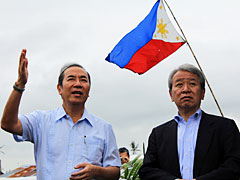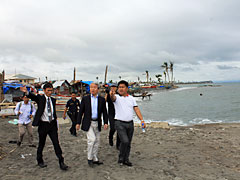
Public Works and Highways Secretary Rogelio L. Singson, left, shows Japan’s ODA assisted school building, which survived strong wind and storm surge, to JICA President Akihiko Tanaka.
JICA President Akihiko Tanaka visited the Philippines from Feb. 21 to 24. He visited Leyte province, which sustained great damage from Typhoon Haiyan (1) in November, and held talks in Manila with parties related to the peace process in conflict-affected areas in Mindanao who are advancing measures toward a Comprehensive Peace Agreement on Bangsamoro.
On Feb. 22, Tanaka visited the towns of Palo and Tanauan in Leyte, as well as the capital of the province, Tacloban City, with Rogelio L. Singson, secretary of the Department of Public Works and Highways. Those areas suffered severe damage from the storm surge brought by Typhoon Haiyan. Tanaka’s visit took place more than 100 days after the typhoon, but the state of damage of the houses and public facilities was still severe. Tanaka confirmed, along with Singson and Philippine local government stakeholders, that there are still many problems facing the country’s restoration efforts. He also observed a necessity for a rapid response to the needs of the people through quick impact projects.
In addition, Tanaka witnessed that people have returned to the coastal area that suffered multiple casualties and begun living in tents and makeshift houses despite the government's designation of the area as a No Build Zone (2).
Tanaka also emphasized to Philippine government officials that it is important that they establish an appropriate land use plan to create a region resilient to the next disaster and offer the people a safe place to live. With this, he explained that JICA will provide technical cooperation through its assistance to establish a long- to medium-term recovery plan. He also discussed with the governor of Leyte province the need to diversify the means of livelihood of disaster victims and to increase productivity. They affirmed that they will mutually examine how to materialize future cooperation by JICA.

The Tanauan mayor, right, explains damage caused by a storm surge to JICA President Tanaka, middle, at the beach of San Roque Barangay, Tanauan.
On Feb. 21, before his visit to Leyte province, Tanaka met with Cesar A. V. Purisima, secretary of the Department of Finance, and Arsenio Balisacan, Socioeconomic Planning secretary and director-general of the National Economic and Development Authority, in Manila. Tanaka announced that in response to the damage from Typhoon Haiyan, and based on the experiences of Japan (including those of the Great East Japan Earthquake), Japan will provide assistance to make the Philippines a country that is resilient to disasters, in keeping with the Philippine government's Build Back Better (3) philosophy.
Also, regarding the areas affected by the conflict in Mindanao, he welcomed the fact that conclusion of a Comprehensive Peace Agreement on Bangsamoro is imminent in response to the agreement on all annexes to the Framework Agreement on Bangsamoro in January. He explained that JICA will continue to support establishing sound systems toward the creation of the Bangsamoro Government, through human resource development, development planning, as well as mid- to long-term regional development, which can lead to improvement of livelihoods and job creation for the people.
On Feb. 23, Tanaka held talks with Chairman of the Bangsamoro Transition Commission (4) and the Moro Islamic Liberation Front Peace Panel Chair Mohagher Iqbal in Manila. Iqbal expressed gratitude for JICA's earlier and continuing support to the areas affected by the conflict in Mindanao (5). He expressed hopes for JICA’s assistance towards achieving a quick and visible impact so that people can feel the dividends of peace and better trust the Bangsamoro Government.
Notes:
- 1 . A typhoon "of an unprecedented magnitude" that occurred in November 2013 in the Philippines. There were 6,201 people killed, 28,626 casualties, 1,785 people missing and 16 million people affected. From November to December, JICA sent Japan Disaster Relief teams, three successive medical teams and two teams of experts, and provided 60 million yen of relief items.
- 2 . In response to Typhoon Haiyan, the Philippine government announced that the area 40 meters from the coast was a No Build Zone.
- 3 . Not simply restoring the disaster area to its previous condition, but rebuilding it into a better state.
- 4 . A committee was established to advance the formation of the Bangsamoro Basic Law, based on the Framework Agreement for Bangsamoro concluded in October 2012 between the Philippine government and the Moro Islamic Liberation Front (MILF).
- 5 . JICA has been engaged in assistance to the conflict-affected areas in Mindanao. This has included the dispatch of experts to the social economic development department of the International Monitoring Team, the cultivation of people in charge of post-peace development, community development, future development planning, and the creation of occasions for dialogue between peace stakeholders. In addition, beginning in July 2013, JICA began the Comprehensive Capacity Development Project for Bangsamoro, in which it is assisting with the creation of organizations and systems including the Bangsamoro Basic Law, the formulation of a development plan, and human resource development for the future Bangsamoro government.




scroll